Nanotechnology. Not only useful, but also beautiful
 Bashny.Net
Bashny.Net
Materials Research Society (Materials Research Society) since 2005 twice a year holds a very original contest titled "Science as Art».
At this competition, researchers from around the world send in photos of micro- and nanostructures in the truest sense of unearthly beauty. Next photo description to create the most beautiful of them.
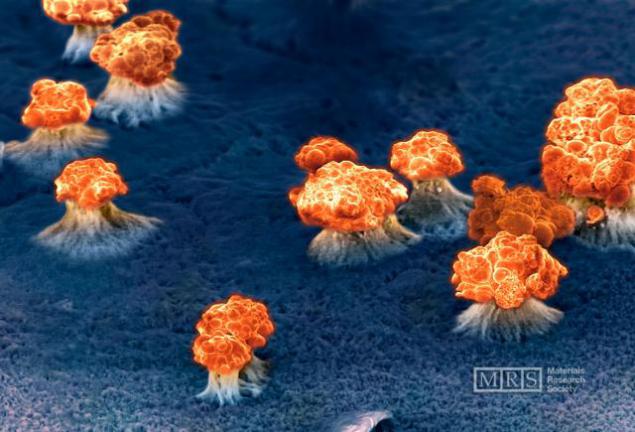
1) Below is the picture presented is called "Dandelion in the nanoworld." It was created as follows. On the silicon substrate by chemical vapor deposition (deposition on the surface of the substrate a thin film of a substance which is a product of decomposition reactions or vapor of one or more compounds) synthesized boron nitride nanotube diameter of about 50 nm. Thereafter, the arrays of tubes photographed at several scales scanning electron microscope (SEM). A little bit of Photoshop to create the composition and paint a picture of a nice looking colors - and nano-dandelion ready.

"Dandelion in the nanoworld." Author: Chee Huei Lee, Michigan Technological University, USA
2) Another nitride - indium nitride synthesized on zinc sulfide crystals by molecular beam epitaxy ("rise" in ultrahigh vacuum on the surface of a single crystal of another), forms a structure is also similar to a flower. True, not a dandelion, but rather on a rose. The width of the "petals" - a few hundred nanometers thick - a pair of tens.

"Nanotsvetok." Author: PaiChun Wei, National Taiwan University
3) Zinc oxide is also deposited from a gas, but without chemical reaction (physical vapor deposition) may form a beautiful like structures fantastic colors.
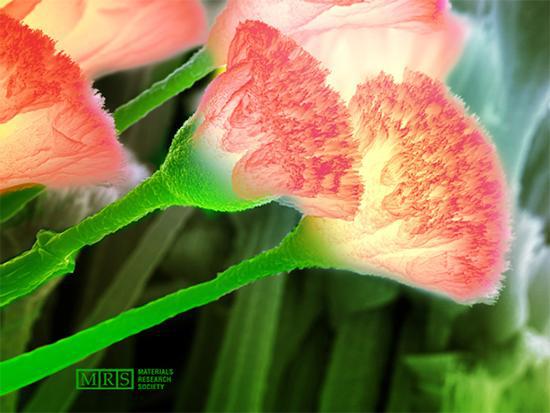
"Glowing Flowers Pandora." Author: Jian Shi, University of Wisconsin, USA
4) These "sunflower" are synthesized by the reaction of silicon with oxygen, where the catalysts were molten gallium and gold. In the middle of the "flower" of silicon oxide nanowires (thickness of about 10 nm, by the way) are packed tightly, and the edges - much more loosely, and thereby form "petals».

"Sunflower field." Author: S.K. Hark, The Chinese University of Hong Kong
5) Sometimes to catch a good picture, you need time to turn imagination. In black and white - namely those frames gives the electron microscope - learn to zinc oxide nanostructures Teddy obviously was not so easy. After painting the picture, of course, is another matter. And the truth is - the bear.
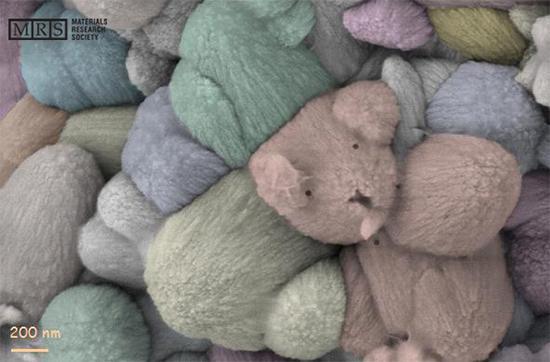
"Nanomedved Teddy." Author: Helia Jalili, University of Waterloo, Canada
6) A University of Illinois have managed to discover a miniature Santa Claus on the surface of a hydrophobic synthetic composites.
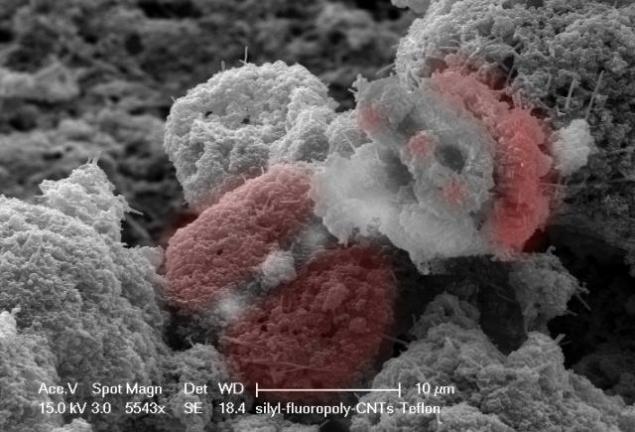
"Nano-Santa." Author: Adam Steele, University of Illinois, USA
7) Some people prefer not to pry in nature and do nanoiskusstvo own. Depicting Jesus Christ reproduction paintings of William Blake "Ancient of Days" has dimensions of 500x500 microns. She "painted" on the porous silicon using a focused beam of helium and subsequent etching with hydrofluoric acid.
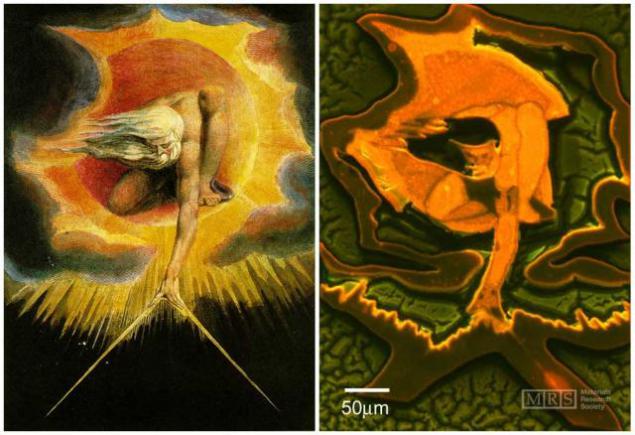
"Ancient of Days." Author: Ee Jin Teo, National University of Singapore
8) Back in the ancient world, people created megalithic composition, and even today the giant buildings is not exactly easy to surprise. But Stonehenge of silicon pillars height only in microns - is another matter. This is not every day you see.

"Modern Stonehenge." Author: Nikolai Chekurov, Helsinki University of Technology, Finland
9) The dice is not as monumental as Stonehenge. But do not look less interested. The size of each - 200 microns, they are made of nickel. If the larger picture, it becomes evident that the bones are hollow.

«Dirty Dice». Author: Timothy Leong, Johns Hopkins University, USA
10) Scientists are also often inspires the creation of landscapes. For example, an array of nanowires CoFeB was such apocalyptic picture.
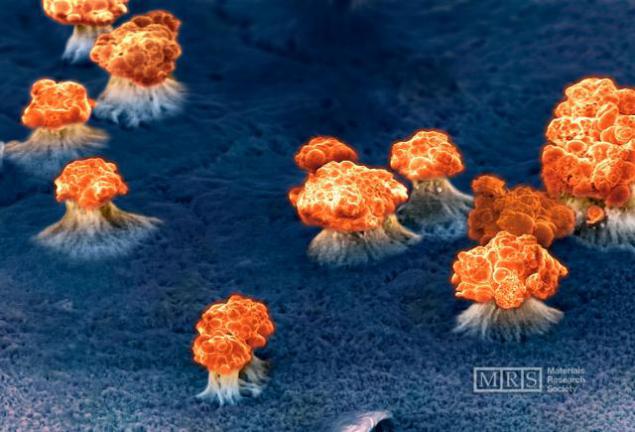
"Nanovzryvy." Author: Fanny Beron, Polytechnic School of Montreal, Canada
11) And the night landscape composed of SEM pictures of particles of pollen, the alumina coating.
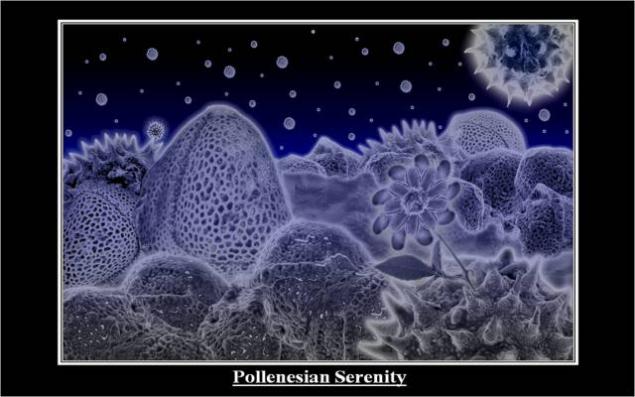
"Pollen serenity." Author: Adam Jakus, Georgia Institute of Technology, USA
12) But, of course, a favorite destination for which scientists constantly pushes nature - this is abstraction. The paintings, which are in search of artists have to use potent substances that alter consciousness, scientists can just see on the screen of an electron microscope. For example, tremendous nanostructure zinc oxide synthesized by the method of "vapor-liquid-solid" (growing crystal from the gas using a liquid as a catalyst).
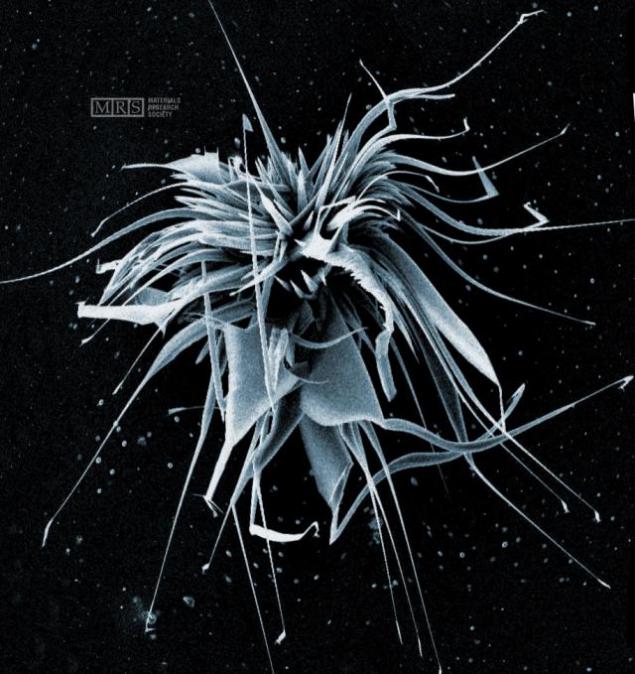
"Nano-Witch." Author: Wen Hsun Tu, National Taiwan University
13) A such beauty can be obtained using anisotropic etching of the diamond crystal microscopic droplets of molten nickel (pictured - red) derived from deposited on the surface of the diamond film with a thickness of 100 nanometers.
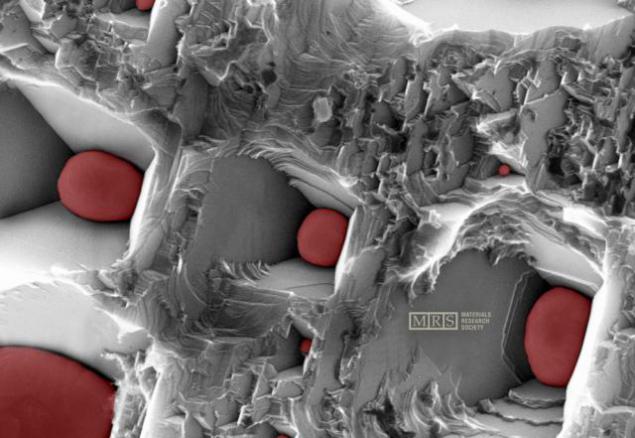
"Squaring the Circle". Author: Waldemar Smirnov, Fraunhofer Institute for Applied Solid State Physics, Germany
14) The crystals of copper selenide (plates) and indium selenide (needles) form an intricate sculpture on the surface of the film copper-indium selenide.
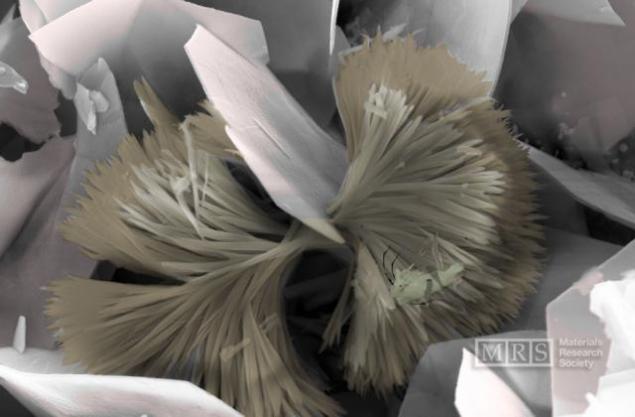
"The beauty of nature. Author: Olga Volobujeva, Tallinn Technical University, Estonia
15) Self-assembled arrays of carbon nanotubes is really very similar to the sky with a Van Gogh painting "Starry Night." And remind background of one of the artist's self-portraits.

"Nanotubes Van Gogh & quot ;. Author: Mariela Bravo-Sanchez, University of San Luis Potosi, Mexico
At this competition, researchers from around the world send in photos of micro- and nanostructures in the truest sense of unearthly beauty. Next photo description to create the most beautiful of them.

1) Below is the picture presented is called "Dandelion in the nanoworld." It was created as follows. On the silicon substrate by chemical vapor deposition (deposition on the surface of the substrate a thin film of a substance which is a product of decomposition reactions or vapor of one or more compounds) synthesized boron nitride nanotube diameter of about 50 nm. Thereafter, the arrays of tubes photographed at several scales scanning electron microscope (SEM). A little bit of Photoshop to create the composition and paint a picture of a nice looking colors - and nano-dandelion ready.

"Dandelion in the nanoworld." Author: Chee Huei Lee, Michigan Technological University, USA
2) Another nitride - indium nitride synthesized on zinc sulfide crystals by molecular beam epitaxy ("rise" in ultrahigh vacuum on the surface of a single crystal of another), forms a structure is also similar to a flower. True, not a dandelion, but rather on a rose. The width of the "petals" - a few hundred nanometers thick - a pair of tens.

"Nanotsvetok." Author: PaiChun Wei, National Taiwan University
3) Zinc oxide is also deposited from a gas, but without chemical reaction (physical vapor deposition) may form a beautiful like structures fantastic colors.

"Glowing Flowers Pandora." Author: Jian Shi, University of Wisconsin, USA
4) These "sunflower" are synthesized by the reaction of silicon with oxygen, where the catalysts were molten gallium and gold. In the middle of the "flower" of silicon oxide nanowires (thickness of about 10 nm, by the way) are packed tightly, and the edges - much more loosely, and thereby form "petals».

"Sunflower field." Author: S.K. Hark, The Chinese University of Hong Kong
5) Sometimes to catch a good picture, you need time to turn imagination. In black and white - namely those frames gives the electron microscope - learn to zinc oxide nanostructures Teddy obviously was not so easy. After painting the picture, of course, is another matter. And the truth is - the bear.

"Nanomedved Teddy." Author: Helia Jalili, University of Waterloo, Canada
6) A University of Illinois have managed to discover a miniature Santa Claus on the surface of a hydrophobic synthetic composites.

"Nano-Santa." Author: Adam Steele, University of Illinois, USA
7) Some people prefer not to pry in nature and do nanoiskusstvo own. Depicting Jesus Christ reproduction paintings of William Blake "Ancient of Days" has dimensions of 500x500 microns. She "painted" on the porous silicon using a focused beam of helium and subsequent etching with hydrofluoric acid.

"Ancient of Days." Author: Ee Jin Teo, National University of Singapore
8) Back in the ancient world, people created megalithic composition, and even today the giant buildings is not exactly easy to surprise. But Stonehenge of silicon pillars height only in microns - is another matter. This is not every day you see.

"Modern Stonehenge." Author: Nikolai Chekurov, Helsinki University of Technology, Finland
9) The dice is not as monumental as Stonehenge. But do not look less interested. The size of each - 200 microns, they are made of nickel. If the larger picture, it becomes evident that the bones are hollow.

«Dirty Dice». Author: Timothy Leong, Johns Hopkins University, USA
10) Scientists are also often inspires the creation of landscapes. For example, an array of nanowires CoFeB was such apocalyptic picture.

"Nanovzryvy." Author: Fanny Beron, Polytechnic School of Montreal, Canada
11) And the night landscape composed of SEM pictures of particles of pollen, the alumina coating.

"Pollen serenity." Author: Adam Jakus, Georgia Institute of Technology, USA
12) But, of course, a favorite destination for which scientists constantly pushes nature - this is abstraction. The paintings, which are in search of artists have to use potent substances that alter consciousness, scientists can just see on the screen of an electron microscope. For example, tremendous nanostructure zinc oxide synthesized by the method of "vapor-liquid-solid" (growing crystal from the gas using a liquid as a catalyst).

"Nano-Witch." Author: Wen Hsun Tu, National Taiwan University
13) A such beauty can be obtained using anisotropic etching of the diamond crystal microscopic droplets of molten nickel (pictured - red) derived from deposited on the surface of the diamond film with a thickness of 100 nanometers.

"Squaring the Circle". Author: Waldemar Smirnov, Fraunhofer Institute for Applied Solid State Physics, Germany
14) The crystals of copper selenide (plates) and indium selenide (needles) form an intricate sculpture on the surface of the film copper-indium selenide.

"The beauty of nature. Author: Olga Volobujeva, Tallinn Technical University, Estonia
15) Self-assembled arrays of carbon nanotubes is really very similar to the sky with a Van Gogh painting "Starry Night." And remind background of one of the artist's self-portraits.

"Nanotubes Van Gogh & quot ;. Author: Mariela Bravo-Sanchez, University of San Luis Potosi, Mexico
Tags
See also
Colour gray days: gadgets for the mood
Roboforum 2014: Dossier 40 speakers and one big question
10 delightful gardens and parks in which it would be desirable to meet the spring
What is behind the desire to eat chalk
The electromagnetic noise interferes with birds to navigate
Very beautiful Soviet actresses
Beautiful money
Marine nano-aquarium at home.
















